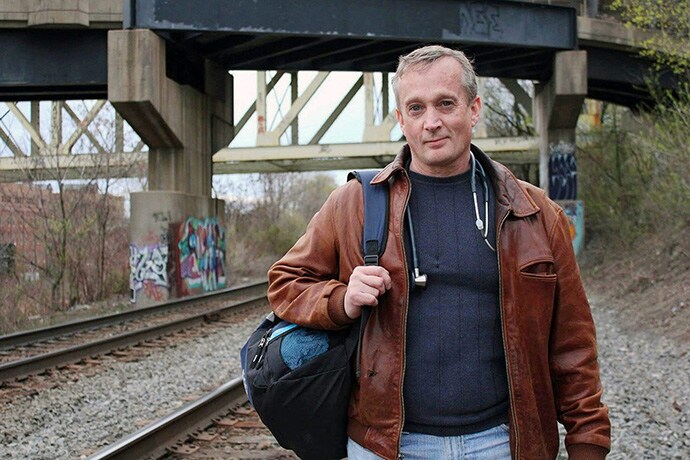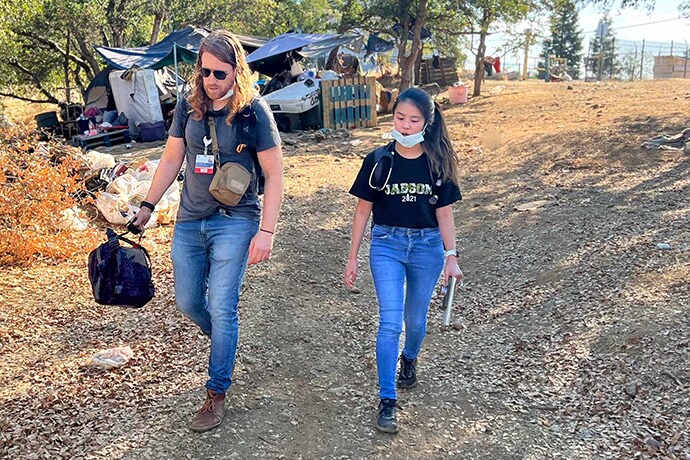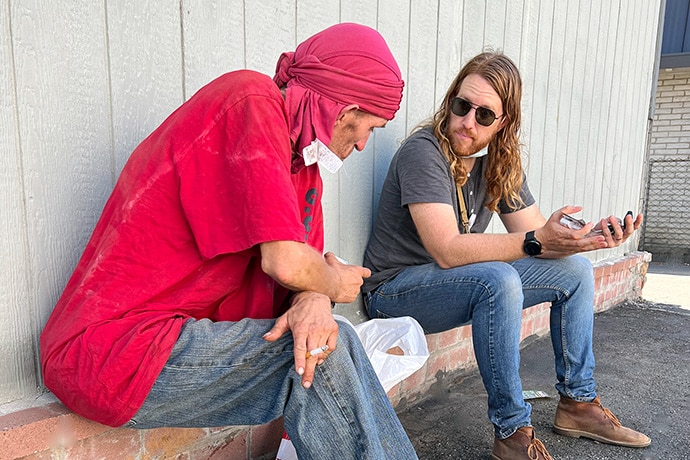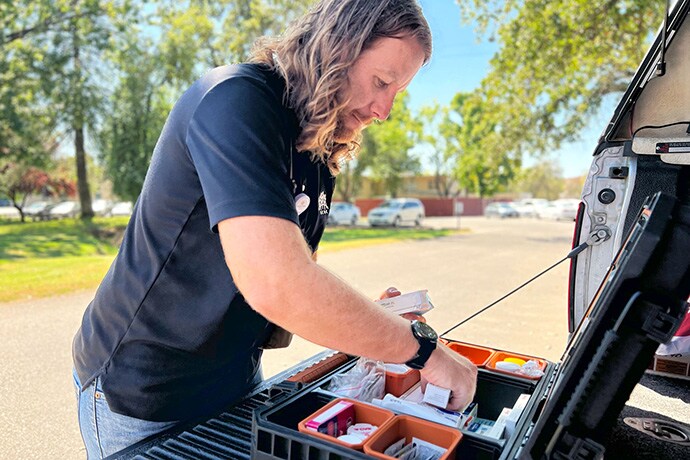One summer evening, on his regular rounds through the streets of Syracuse, NY, David Lehmann, MD, PharmD, came across an unsheltered man in dirty clothes who seemed to be making his bed each night on the pavement where he stood. An exam in the privacy of the medical van revealed a painful, infected boil on the man’s backside.
After some coaxing, Lehmann lanced the infected sore, gave medicine and instructions for care, and handed the man some clean underwear. Pretty standard stuff, he thought.
But then, just as they were parting ways, something unexpected happened: The man broke down. “He just melted into my arms and started crying and hugging me.”
Lehmann was taken aback. Just weeks earlier, he had left conventional medical practice to treat people in the streets. He made the jump because he had tired of seeing unsheltered people arrive at the hospital with emergencies that could easily have been avoided with earlier medical treatment.
On this summer night in 2018, far from the safe, clean, well-stocked, air-conditioned medical offices where he had practiced for most of his career, he learned the need was more than purely medical.
“It’s about providing dignity,” says Lehmann, who does his work through an organization called HouseCalls for the Homeless, which he helped start.
“You have to connect with them as human beings. You never know where it’s going to lead. You can be an influence to get people treated and regain their own humanity,” he says.
The man with the boil is a case in point. That first encounter was the beginning of a relationship that deepened over time. Today, he has found permanent housing and regular employment and his physical and mental health are much improved.
A Great Unmet Need
More than half a million people are homeless in any given year in the United States. And an estimated 192,875 of them are sleeping unsheltered on any given night. In Los Angeles County alone, more than 63,000 are homeless, the vast majority unsheltered, with little to no access to health care.
Many don’t get medical care when they need it because of mental health issues, or a lack of resources, or substance misuse, or something as simple as a lack of ID. And the result can be deadly.
Death rates for the unsheltered are hard to track, but one JAMA study showed that a group of 445 adults (average age 44) who lived unsheltered in Massachusetts between 2000 and 2009 were 10 times more likely to die during that period compared with similarly aged adults in the general population. The National Health Care for the Homeless Council says that amounts to between 17,500 and 46,500 people without shelter who died just in the year 2018.
It’s an immense problem that often flies under the radar, Lehmann says.
The “Father of Street Medicine”
The traditional health care model just doesn’t work for this population, says Jim Withers, MD, who founded the Street Medicine Institute (SMI), which helps expand street medicine globally.

Jim Withers, MD, heads out to work.
Withers, known as the father of street medicine, began his journey into the field 30 years ago after a patient he had just treated at a Pittsburgh hospital walked out into the streets, and just hours later, froze to death.
Withers walked out soon afterward to find unsheltered people where they live. Back then, he dealt more with untreated heart disease and diabetes in an older population. And that’s still a problem: Among people who are homeless, diseases like diabetes, heart disease, and HIV/AIDS still happen at a rate up to six times higher than the general population.
But today, many of the people he treats are younger and drug and opioid misuse takes up far more of his resources.
“In the last decade,” he says, “we’re seeing so many overdose deaths, with fentanyl taking the vast majority.”
While opioid abuse affects everyone — opioid-related overdose deaths have tripled since 2000 — it’s particularly hard on people who are homeless. Substance use disorders are more common among this group, as is the risk of overdose.
In addition, around a fifth of the homeless population report having serious mental illness. This can create an unfortunate cycle because those on the streets with psychiatric and/or substance abuse problems are more likely to live in dangerous conditions and to have sudden, life-threatening physical illnesses.
Without primary care, the unsheltered end up in hospital emergency rooms with multiple, advanced health issues. In California, it is estimated they have 740% more hospital days at 170% greater cost per day than those who are housed.
Meeting People Where They Are
Dave Mooney had been spending his nights in a sleeping bag on the sidewalk when Withers met him in May of 2000. Every week Withers came to check on Mooney where he slept under a porch roof on the South Side of Pittsburgh.
As they built a rapport, Withers helped reduce Mooney’s high blood pressure and connected him with a psychiatrist to help address his mental health issues.
“He was a blessing from the day I met him,” Mooney says of Withers. “He even gave me his cell phone number.”
And yet when, after years of effort, Withers managed to help Mooney get an apartment, Mooney was uncomfortable making the switch. He showered and slept there occasionally but also continued to sleep on the streets — and does so to this day.
You can’t expect someone who lived on the street for 20 years to suddenly move indoors, Mooney says. “Baby steps,” he says. “It’s a transition. I’m used to the freedom.”
Withers holds no ill feeling to Mooney for being unable to completely embrace life indoors. In fact, the two are still close and Mooney often helps Withers’s team track down people in the streets that may need treatment.
It’s another example of how, Withers says, you have to go out and meet people where they are — both physically and mentally.
“You can argue that they should be in a medical office. But if they aren’t and they can’t and they won’t — then they keep dying.”
That is why he has persisted in his work for more than 3 decades.
“It’s an exercise in community building from the street up to find and engage the services and people to treat them the way they deserve to be treated,” Withers says.
Street Medicine: “This Is My Jam!”
The seed Withers planted 30 years ago has since grown. Today, there are about 90 street medicine programs across the country (such as Lehmann’s HouseCalls for the Homeless). Street medicine is now a recognized area of medical study in many quarters with conferences, continuing education, and specialized fellowships. The 18th International Street Medicine Symposium just finished (Sept. 21-24, 2022) in Toronto, Canada.
Kyle Patton, MD, is one of a new generation of street medicine doctors. Now 37, he decided early on to make street medicine his specialty. He created his own fellowship within his residency program.

Patton and medical resident Holly Harada search the encampment for a longtime client who is reportedly having breathing problems.
“Essentially, when I interviewed with the program, I said, ‘I do street medicine. This is my jam. This is what I want to do for my career.’ ” To their credit, Patton says, they found a way to let him carve out that space.
He finished his residency in 2019 and moved to Redding, CA, where he helped develop the Project HOPE street medicine program at Shasta Community Health Center.

Patton talks to an unsheltered man about how to use Narcan in case of an opioid overdose. Substance abuse is a huge issue among the population he treats.
Redding has a critical need for such care. There are around 1,000 people living without shelter in a city of 100,000, Patton says. For comparison, Boston, MA, had only around 175 people living in the streets last year with a population nearly seven times Redding’s.
Patton travels around in his medical van. He doesn’t expect his clients to stay in the same place from week to week.
“If they move to another camp, we’ll see them there. If they drop off the radar and resurface 6 months later, we’ll pick up where we left off — anything we can do to maintain continuity with these folks.”

Wherever he goes, Patton must make do with whatever he has brought with him.
It’s a sign of progress for street medicine that when he finds them, his medical van is well-equipped enough to do ultrasound exams and look up lab reports and medical records. But Patton says, it’s still just a drop in the ocean when you look at the immensity of unmet need.
He measures progress through the words of the people he treats. He wants them to feel comfortable saying: “I have a doctor. I know who to call when I have a problem.”
“That in and of itself is the biggest marker of success for me — my reputation with the patients that I serve.”
Who Pays for It?
In Syracuse, NY, David Lehmann, MD, does his work in the streets as part of his tenured position at Upstate Medical University. But he is quick to acknowledge that not all street medicine programs have that luxury.
For example, in Redding, CA, Kyle Patton, MD, spends much of his time seeking state and federal funding sources as well as grants and donations — time he’d rather spend out treating people in need.
Part of the problem is that it’s hard to get paid for treating people on the streets. Many unsheltered people automatically qualify for federally funded health care (Medicare and Medicaid). But in order to bill for care, medical providers need to give a Place of Service Code — and there’s no code for “out in the streets.”
“The care we’re providing is reimbursable, but because of the location where we provide it, we can’t be reimbursed,” says Brett J. Feldman, MSPAS, PA-C, director of The University of California’s Division of Street Medicine.
It’s a catch-22: Many unsheltered clients won’t come to a medical facility for treatment, either due to fear, lack of knowledge, or mental health issues. And yet when medical providers are ready and willing to go out into the streets to treat them, they can’t get paid.
The predictable result is that funding street medicine programs is a constant struggle with no national model. The Place of Service requirement threatens existing “street medicine” programs and prevents new ones, Feldman says.
That’s why USC Street Medicine together with the Street Medicine Institute have led an effort with more than 500 others to ask Centers for Medicare and Medicaid Services (CMS) to either amend an existing code or add a new one that will allow providers to bill for care in the streets.
The request was submitted in January 2022, but no decision had been made as of September.
Source: Read Full Article
